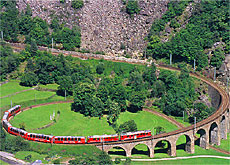
Unesco railway bid is back on track

Switzerland’s Bernina Express is on track to become only the third railway line recognised as a Unesco World Heritage Site, despite a few hitches along the way.
Plans to list only the first half of the route, which crosses the Alps from north to south, caused an outcry further down the line.
The railway journey, which begins in the town of Chur and ends in the Italian town of Tirano, is an engineering marvel of stone viaducts and loops among some of the country’s most spectacular scenery.
It is only about 100km in length, but the journey takes four hours since the train has to bridge deep gorges and climb through high mountain passes.
The railway line has long been considered a wonder of early 20th-century engineering and as one of the most beautiful train journeys anywhere.
The stone viaducts alone are unique in the western world.
“They were built in strange configurations – on curves, on slopes – which really takes masonry construction to its utmost,” said Tom F Peters, author of several works on the history of building technology (see interview under “related items”).
Half a bid
Yet until recently, the Rhaetian Railway proposed putting in a bid to list only half the track – the Albula stretch of the line – as a World Heritage Site.
This proposal, which still has to be approved by the Swiss government before it can go to Unesco, was greeted with outrage by people living along the second part of the line – in the Poschiavo valley.
They accused the Rhaetian Railway of arrogance for attempting to take the decision alone, saying the line belonged not only to the railway but to the regions it passed through as well.
“We were shocked because this railway line is very important for the whole valley,” Cassiano Luminati, a member of the association representing the Poschiavo region, told swissinfo.
The Swiss government came under pressure from Poschiavo and the neighbouring Valtellina region in Italy, where the line ends, to convince the railway to change its mind.
Lifeline
The railway is a lifeline for Poschiavo since it is the only year-round route connecting the Italian-speaking region to the rest of Switzerland.
It also generates income, bringing about 350,000 visitors to Poschiavo each year.
Luminati believes the Unesco label would boost these numbers and create badly needed jobs in this outlying region.
Ernst Bachmann, a vice-president of the Rhaetian Railway, acknowledges that the St Moritz – Poschiavo – Tirano stretch is every bit as outstanding as the Albula section (Chur – St Moritz).
“As a first step we applied for the Albula line to be listed,” he said. “But after discussing the issue in detail, we decided to include the entire line.”
“We were hesitant because we were not sure which conditions would be attached to the heritage label, whether it would entail higher maintenance and restoration costs.”
No additional costs
He said the Swiss government had assured the railway that there would be no additional costs, and he is now certain the inclusion of the whole line is the right choice.
According to Bachmann, the many tunnel loops and high viaducts are the highlights of the line through the Albula valley, while the main attraction of the latter half is the crossing of the Bernina Pass before the long, steep descent into Poschiavo and Italy.
“Going over this pass at 2,253 metres above sea level makes it the highest adhesion railway in the Alps, with an incredible maximum gradient of 1 in 14,” enthused Gian Brüngger, a train buff who works at the Rhaetian Railway headquarters.
“These two lines have changed little since they were first built. It would be great if they became a World Heritage Site.”
If Brüngger’s wish is granted, the Bernina Express line will be declared a Unesco World Heritage Site as early as 2008.
swissinfo, Dale Bechtel on the Bernina Express
The Swiss government is considering asking Unesco to list the Bernina Express railway line as a World Heritage Site.
There are currently two railway lines recognised by Unesco: Austria’s Semmering Railway and the Darjeeling Himalayan Railway.
The Bernina Express line starts in Chur, the capital of the canton Graubünden, located at 584m.
It travels along stone viaducts and through spiral tunnels in the Albula valley before reaching the Engadine.
From St Moritz, it continues over the Bernina Pass (2,253m) and down to Switzerland’s Poschiavo valley and Tirano in Italy (429m).

In compliance with the JTI standards
More: SWI swissinfo.ch certified by the Journalism Trust Initiative





























You can find an overview of ongoing debates with our journalists here . Please join us!
If you want to start a conversation about a topic raised in this article or want to report factual errors, email us at english@swissinfo.ch.